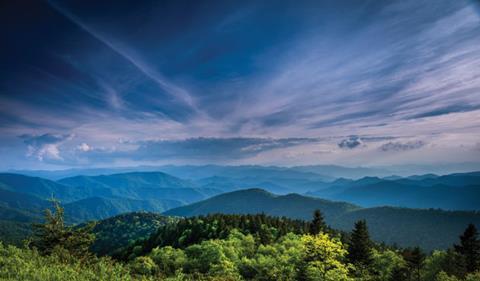Simon Cotton explores nature’s building block
The Blue Ridge Mountains conjure a romantic vision of the central Appalachian Mountains on the east coast of the US, immortalised by Dolly Parton, John Denver and the Grateful Dead, among others. They take their name from the bluish haze that hangs over them, but they are not the only mountain range that experiences this atmospheric mist: the Blue Mountains north of Sydney, Australia, also take their name from this phenomenon.

We are well aware of air pollution caused by cars and industry, but this effect is natural air pollution. Trees give out a range of small organic molecules, and the one emitted in greatest amount, comparable with natural emissions of methane, is called isoprene. Worldwide, trees and shrubs emit around 500 million tons of isoprene into the air each year.
Changing the atmosphere
Isoprene is the building block of important natural molecules called terpenoids. These molecules form aerosols that scatter sunlight – the scattering is enhanced at short wavelengths, which is where the blue colour comes from. Isoprene emission is thought to have a protective effect on plants. This comes not just from repelling insects but from protecting against other dangers, like heating, that interfere with photosynthesis.
The emission of these small molecules also has an impact on atmospheric chemistry – as they react with nitrogen oxides that are naturally present in the air, ozone is formed. Up in the stratosphere, ozone is a good thing – it protects us from ultraviolet radiation. But at ground level ozone is toxic to organisms, causing respiratory problems in animals.
This adds subtle considerations to tackling air pollution. Planting bioenergy crops, like trees that can be used as fuels, is a good thing, not least because it removes carbon dioxide from the atmosphere. However, these trees are also projected to lead to more ozone emissions than traditional crops, because of how quickly they grow. Plants make terpenoids for various reasons. Some attract insects to pollinate them, others to repel insect pests. For example, molecules like santalol make sandalwood and cedarwood resistant to attack. Terpenoids create colours, like lycopene in tomatoes and β-carotene in carrots and sunflowers. They are also responsible for the scent of plants, like limonene in citrus fruit, menthol in mint, linalool in lavender or the pinene that gives pine trees their scent.
A natural polymer
Another substance, a polymer of isoprene, is particularly useful: rubber. On 15 April 1770, the English chemist Joseph Priestley observed ‘I have seen a substance excellently adapted to the purpose of wiping from paper the mark of black lead pencil’ and so called it ‘rubber’. The rubber tree Hevea brasiliensis makes latex, a sticky white fluid, as a protection against herbivores. Latex is a watery suspension of rubber particles.
The polymeric chains in rubber contain between 320 and 35,000 isoprene units bound together with double bonds in a cis arrangement. This makes the chains stretchy. This is very useful in rubber bands, but does limit rubber’s applications.
In 1839 an American inventor named Charles Goodyear found that if you added some sulfur to the rubber, then heated it, the process made the rubber into the stronger and harder black solid that we know today. Sulfur forms cross-links between the polymer chains, so they don’t slip past each other, making the rubber much more rigid. Of course, this is the basis of car tyres. When you heat it, rubber depolymerises very slightly, so hot tyres smell of isoprene.
Large quantities of isoprene are used industrially today, nearly all of it to make synthetic rubber, and it is produced by the petroleum industry through cracking oil, making about a million tonnes each year. Nevertheless, as usual, nature got there first.









No comments yet